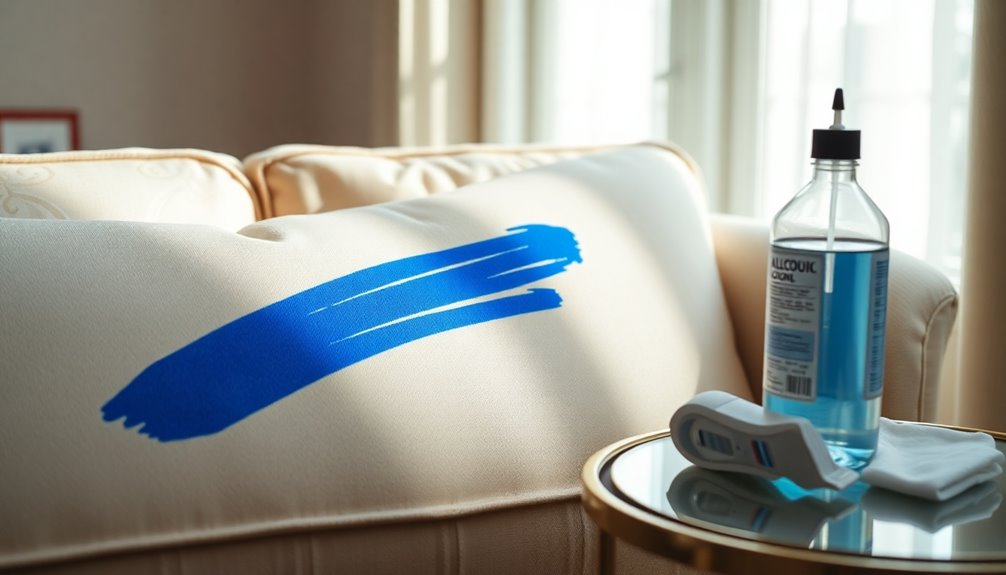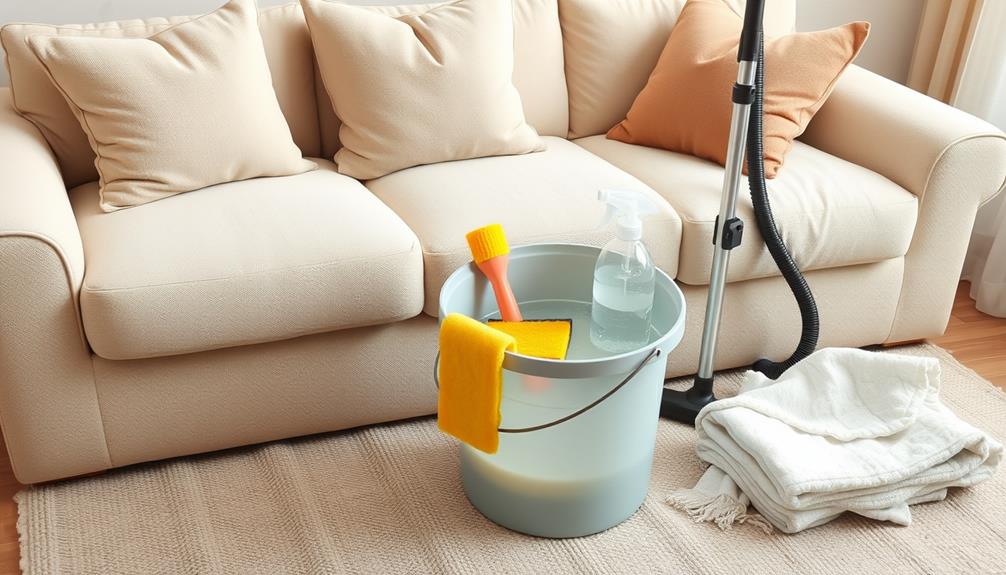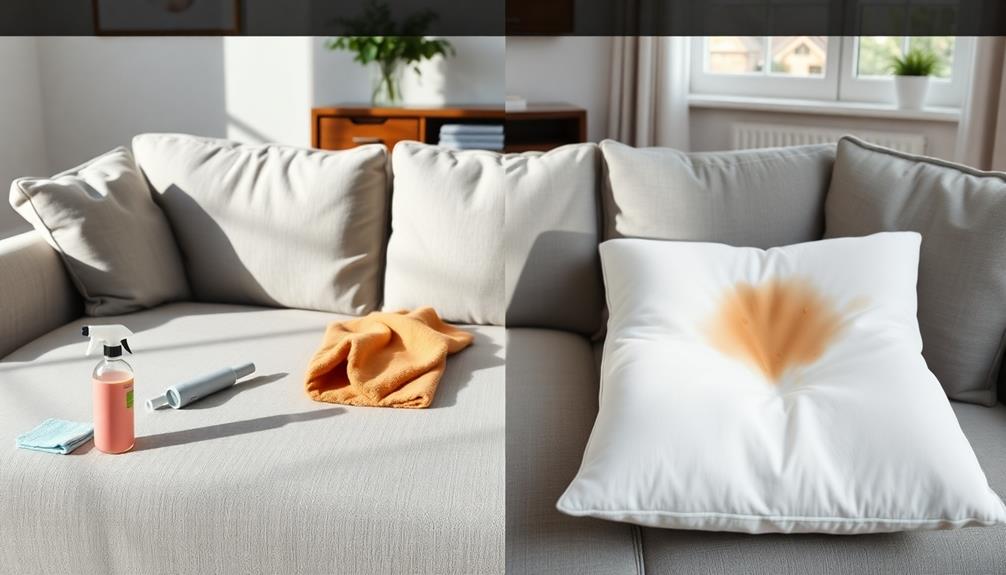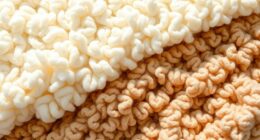To remove pen marks from your sofa, first identify the fabric type using the cleaning code. For water-safe fabrics, mix equal parts of vinegar and water, and dab it on the stain with a cloth. If your fabric is solvent-only, use rubbing alcohol on a cotton ball to blot the ink. Always test any solution on an inconspicuous area first. Act quickly to prevent the ink from setting, and remember to avoid scrubbing, as this can worsen the stain. Continue exploring other helpful tips to keep your sofa looking its best!
Key Takeaways
- Identify the fabric cleaning code on your sofa to choose the appropriate cleaning method for pen marks.
- For water-safe fabrics (W), use a vinegar solution to blot away ink stains.
- For solvent-only fabrics (S), apply rubbing alcohol directly to the pen mark and blot gently.
- If the fabric is S-W, you can use both water and solvent-based solutions for cleaning.
- Always test any cleaning solution on an inconspicuous area of the fabric before full application.
Introduction
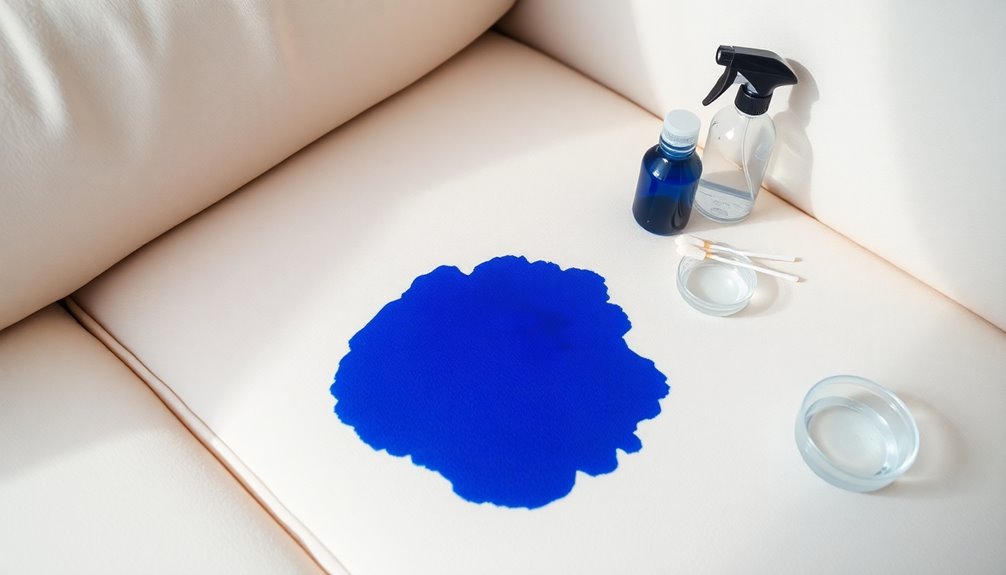
When it comes to keeping your sofa looking great, routine fabric care is key. You'll want to know specific cleaning techniques for different materials, especially when dealing with pesky ink or food stains. Understanding how to target these stains effectively can save your furniture from permanent damage.
Routine Fabric Care Practices
How can you keep your sofa looking fresh and free from stains? It starts with routine fabric care practices that help maintain its appearance. First, vacuum your sofa weekly to remove dirt and debris. This simple step can prevent stains from setting in and prolong the life of your fabric.
When spills occur, act fast! Blotting with a clean cloth helps absorb excess liquid and stops stains from becoming permanent. Don't forget to check the manufacturer guidelines to find the right cleaning solution for your specific fabric type. Using the wrong method could damage your sofa.
To add an extra layer of protection, consider applying a fabric protector spray periodically. This creates a barrier against future stains and spills, making cleanup easier. By following these steps, you ensure your sofa stays clean and looks great for years to come.
Incorporating these routine fabric care practices into your cleaning regimen will not only enhance your sofa's longevity but also keep it looking pristine. Remember, regular maintenance is key in protecting your investment!
Fabric-Specific Cleaning Techniques
Understanding the specific cleaning techniques for your sofa's fabric is crucial for effectively removing stains without causing damage. Start by checking the cleaning code on your fabric couch. For water-safe fabrics (W), you can safely use a vinegar solution mixed with dishwashing detergent to remove ink stains. This method is gentle yet effective against stubborn stains.
If your sofa is made from solvent-only fabrics (S), the rubbing alcohol method is your best bet. Apply a small amount of rubbing alcohol to a clean cloth and gently dab the ink stain. Avoid saturating the fabric, as excess moisture can cause damage.
For upholstery coded as S-W, you have the flexibility to use both water and solvent-based cleaning solutions, which makes it easier to tackle any ink marks. However, if your fabric is labeled with an X, it's essential to refrain from any cleaning attempts at home. These fabrics should only be vacuumed and require professional cleaning to prevent damage. By following these fabric-specific techniques, you can effectively remove ink stains while preserving your sofa's integrity.
Targeting Ink and Food Stains
Ink and food stains can wreak havoc on your sofa, but quick action can make all the difference. When ink spills occur, the type of ink matters; ballpoint pen ink is generally easier to remove than fountain pen ink, which may require specialized cleaning methods. To tackle fresh ink stains, grab some rubbing alcohol. Dampen a clean cloth with it and gently blot the stain, being careful not to rub, as that can push the ink deeper into the fabric. For dried ink stains, you might need to repeat this process several times.
For water-based food stains, a solution of vinegar and dish soap works wonders. Mix equal parts vinegar and soap, apply it to the stain, and gently blot until the stain lifts away. Always remember to test any cleaning solution on an inconspicuous area of your sofa first to avoid damaging the fabric.
Regular maintenance and prompt treatment of spills not only help you remove stains effectively but also preserve the integrity and appearance of your sofa, minimizing the risk of permanent marks.
Avoiding Direct Sunlight Exposure
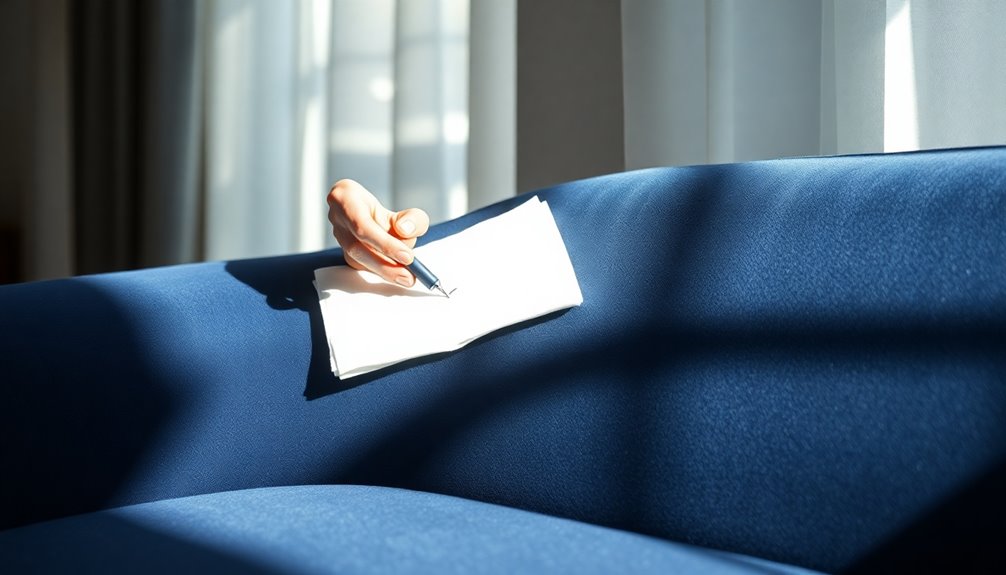
To protect your sofa from the damaging effects of sunlight, consider choosing scratch-resistant fabrics that hold up better over time. Using decorative throws can add an extra layer of protection while enhancing your decor. Additionally, applying protective fabric sprays can help shield your upholstery from both sun damage and pesky ink stains.
Scratch-Resistant Fabric Selection
Choosing the right scratch-resistant fabric for your sofa can make a big difference in how well it stands up to everyday wear and tear, especially when it comes to pesky pen marks. Opt for scratch-resistant fabrics like microfiber or synthetic blends. Their tightly woven fibers and durable surfaces help prevent ink from soaking in, making cleaning up ink stains much easier.
When selecting your fabric, look for options with a high rub count rating—over 15,000 is ideal. This ensures greater durability against scratches and stains, perfect for homes with kids or pets. However, remember that even the best fabrics can suffer if exposed to direct sunlight. Prolonged UV exposure can weaken fibers and lead to discoloration, so try to keep your sofa out of harsh light.
Interestingly, just like how sugar content in candies can affect their preservation and longevity, the right fabric choice can significantly influence the lifespan of your sofa. If you do encounter pen marks, use gentle methods like rubbing alcohol or a vinegar solution for cleaning. These approaches safeguard the protective coating on your fabric while effectively removing stains. By making thoughtful fabric selections and taking care of your sofa, you'll enjoy a stylish and resilient piece of furniture for years to come.
Fabric Protection With Decorative Throws
Adding decorative throws to your sofa can significantly enhance its protection against wear and tear while also elevating your room's style. These throws protect your sofa from spills and stains, providing an extra layer of defense against everyday mishaps. When selecting decorative throws, opt for those made from durable materials that are also washable. This ensures easy maintenance and longevity, allowing them to withstand daily use.
Position your throws strategically to minimize direct sunlight exposure on your sofa fabric. This simple step can prevent fading and degradation over time, keeping your sofa looking fresh and vibrant. Regularly rotating and washing your decorative throws not only maintains their appearance but also extends the life of the underlying fabric. Incorporating decorative throws can harmonize beautifully with other elements such as Indonesian decorative pillows, enriching the cultural touch of your living space.
Incorporating decorative throws into your interior design allows for seasonal decor changes, giving your space a fresh look without a complete overhaul. With this versatile approach, you can easily adapt your room's aesthetic while ensuring your sofa remains protected. So, don't underestimate the power of decorative throws; they're a stylish solution to maintain your sofa's beauty and durability for years to come.
Using Protective Fabric Sprays
Protective fabric sprays serve as an essential line of defense against stains, including pesky pen marks that can mar your sofa's appearance. By creating a barrier, these sprays make it easier to wipe away marks before they set into the upholstery material. It's crucial to choose a fabric spray compatible with your specific fabric to avoid damage or discoloration.
For maximum effectiveness, apply the protective spray in a well-ventilated area. After application, allow it to dry completely before exposing the fabric to direct sunlight. Sunlight can degrade the spray's effectiveness and compromise your sofa's protection. Regular application is key; doing so will help maintain the fabric's appearance and prolong its lifespan, ultimately reducing the frequency of deep cleaning needed.
Always follow the manufacturer's instructions on the protective spray label for proper application. This ensures that you're getting the most out of the product while safeguarding your upholstery from stains. By incorporating protective fabric sprays into your maintenance routine, you can enjoy a cleaner, more vibrant sofa that withstands everyday wear and tear, making your living space more inviting and stylish.
Upholstery Cleaning Frequency
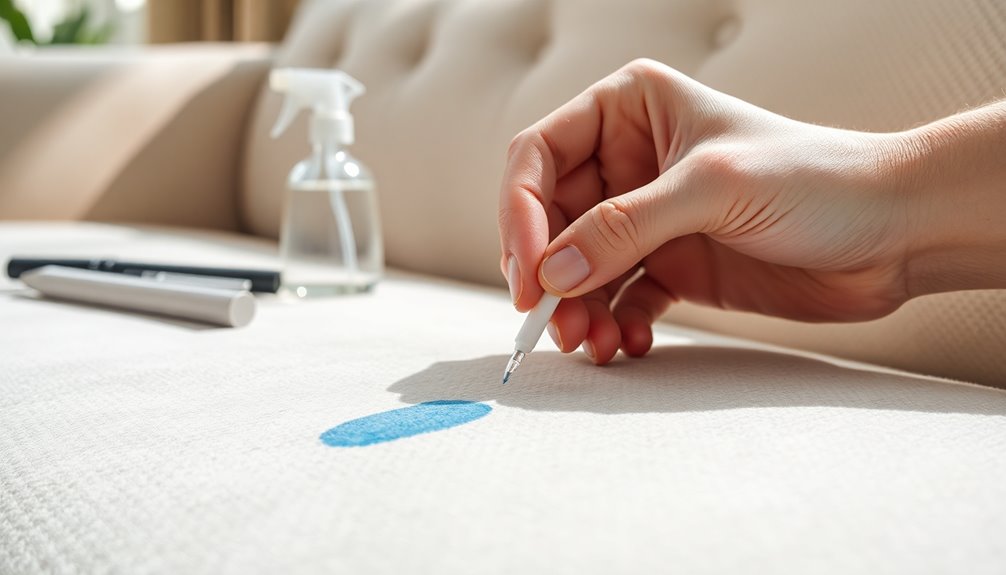
You should clean your upholstery regularly to keep it looking fresh and prevent any couch frame stability issues. By revitalizing furniture surfaces through routine maintenance, you can enhance your overall upholstery experience. Staying on top of cleaning not only protects your investment but also makes your living space more inviting.
Couch Frame Stability Concerns
Maintaining the stability of your couch frame hinges on regular upholstery cleaning, which plays a crucial role in preserving its structural integrity. Dirt and grime can accumulate over time, compromising the strength of both the fabric and the frame. To avoid this, establish a cleaning frequency based on your sofa's usage; high-traffic areas should ideally be cleaned every 6-12 months.
When cleaning, it's vital to use the right products for your upholstery material. For "W" coded fabrics, water-based solutions work well, while "S" coded materials require solvent-based cleaning methods, often involving alcohol. Neglecting this maintenance can lead to unsightly stains and even sagging, which can jeopardize your couch's stability.
Regularly inspecting your sofa for stains or wear will help you identify areas that need immediate attention. This proactive approach not only enhances the aesthetic appeal of your furniture but also extends its lifespan, ensuring you continue to enjoy comfort and support. Remember, a well-maintained sofa isn't just about looks; it's crucial for maintaining the overall stability of your couch frame.
Furniture Surface Revitalization
Revitalization of furniture surfaces hinges on consistent upholstery cleaning practices that enhance both appearance and durability. Regular upholstery cleaning every 6 to 12 months is essential to maintain your sofa's look and prevent the buildup of dirt and stains. Frequent vacuuming can help you remove dust and debris, which, if left unchecked, may cause wear and tear on the fabric over time.
For households with pets or children, consider more frequent cleaning, ideally every 3 to 6 months, to effectively manage spills and stains. Addressing minor stains promptly can prevent them from setting, reducing the need for more intensive cleaning methods later on.
When tackling stubborn stains or deep-set dirt, don't hesitate to utilize professional cleaning services. These experts employ effective cleaning methods that can rejuvenate your upholstery and restore its original charm. Additionally, understanding the importance of legal representation can provide peace of mind during stressful times, such as after a divorce. Remember, staying proactive with your cleaning routine not only enhances the appearance of your furniture but also extends its lifespan, ensuring you enjoy a beautiful and comfortable living space for years to come.
Uplifting Upholstery Experience
Keeping your upholstery in top shape requires a consistent cleaning routine that fits your lifestyle. Aim for regular cleaning every 6 to 12 months to maintain its appearance and durability. Don't underestimate the power of frequent vacuuming; it helps prevent dirt buildup, which can lead to fabric wear and potential staining.
When spills occur, immediate spot cleaning is crucial, especially for removing ink stains. Use a cleaning agent suited for your fabric type, as indicated by the cleaning code, to protect your upholstery integrity. The sooner you address stains, the better your chances of successful removal.
Incorporating a protective fabric spray into your routine can further enhance your upholstery experience. This not only helps resist stains but also makes future cleaning efforts easier, extending the lifespan of your furniture. Remember, using appropriate cleaning methods is key to preserving the quality of your upholstery. Additionally, utilizing top rated vacuums can significantly improve your cleaning efficiency and effectiveness.
Fabric Color Protection Strategies
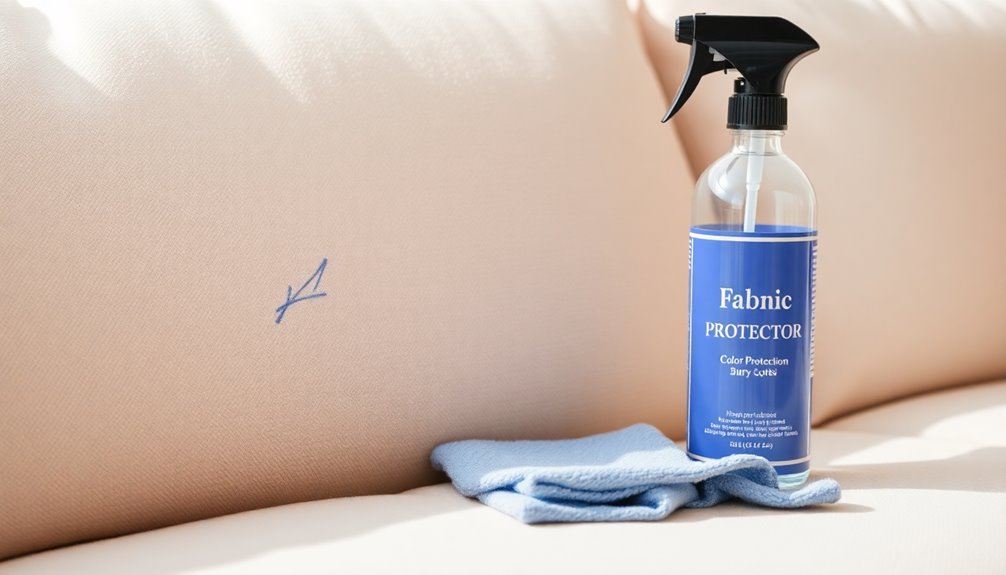
Protecting your sofa's fabric color starts with proactive measures that can save you time and effort in the long run. One effective strategy is to apply a fabric protector spray, which helps create a barrier against stains, making it easier to clean pen marks and other spills without damaging your upholstery. Additionally, choosing upholstery fabrics with stain-resistant finishes can significantly reduce the chances of ink stains becoming set into the material.
Regularly vacuuming your sofa is another crucial step. By removing dirt and debris, you prevent them from embedding into the fabric, which may lead to discoloration and make ink stains more noticeable. When dealing with spills, it's essential to act quickly. Promptly addressing these incidents helps maintain the fabric color by preventing deeper penetration into the fibers.
Before using any cleaning solution, always test it on an inconspicuous area of the sofa. This ensures that the fabric's color and integrity are preserved when you apply the cleaning agent to the stained area. By following these fabric color protection strategies, you can keep your sofa looking fresh and vibrant for years to come.
Routine Stain Prevention Tips
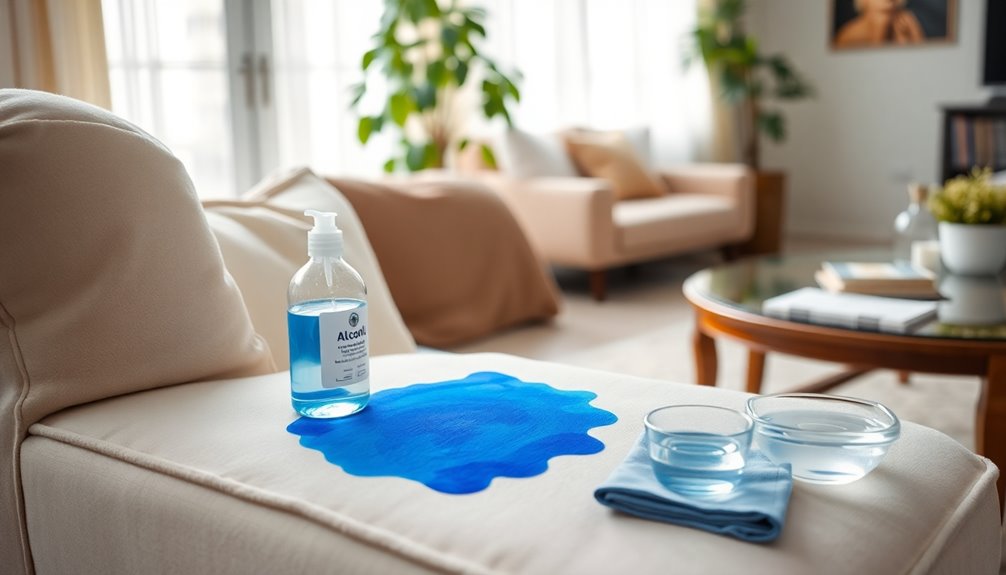
Maintaining a stain-free sofa requires diligence and a few simple strategies. Start by regularly vacuuming your sofa to remove dust and debris, which can contribute to staining and complicate cleaning ink marks when they occur. Implementing routine checks for any ink or pen marks is crucial; address them immediately using appropriate cleaning methods to prevent them from becoming permanent stains.
To further prevent stains, consider using fabric protectants specifically designed for upholstery. These create a barrier against stains, including ink, and help ensure they don't set. It's also wise to encourage household members to avoid using pens or markers on the sofa, especially in seating areas, to reduce the risk of accidental stains.
Establishing a "no food or drink" rule in your living area is another effective strategy. Limiting spills minimizes the chance of ink stains or exacerbates existing ones. Remember, if you do spot a stain, always clean before drying to ensure the best results. By incorporating these tips into your routine, you'll maintain a cleaner, more inviting sofa for everyone to enjoy.
Conclusion
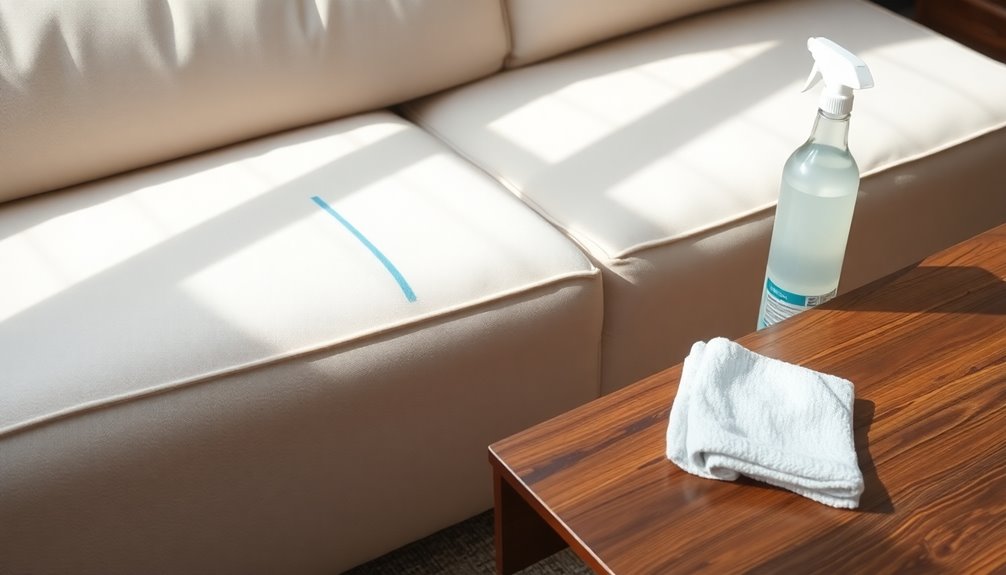
Taking prompt action when dealing with pen marks on your sofa can make all the difference in preserving its appearance. Fresh ink stains are much easier to treat than dried ones, so don't hesitate. Start by checking your sofa's cleaning code to ensure you're using the right method for your specific sofa fabric. Rubbing alcohol is a great go-to solution; simply apply it gently with a clean cloth and blot the stain rather than rubbing, which can spread the ink.
If you're dealing with lighter fabrics, a mixture of dishwashing detergent and white vinegar can be another effective option. Always remember to test any cleaning solution on an inconspicuous area first to avoid damage. For persistent ink stains that resist home treatment, don't hesitate to seek professional cleaning. These experts have the right tools and knowledge to handle tough stains safely, ensuring your sofa remains in top shape. Additionally, maintaining a clean environment with effective air filtration can help prevent dust and debris from settling into fabric and making stains harder to remove.
Frequently Asked Questions
How Can I Remove Ballpoint Pen Stains From Sofa?
To tackle ballpoint pen stains, you'll want to act quickly. Start by blotting the stain gently with a clean cloth to soak up excess ink. Then, grab some rubbing alcohol on another cloth and dab the stain, working from the edges inward. If it's still there, mix dish soap and vinegar with warm water to blot the area. Always test any solution first, and rinse afterward to keep your fabric safe.
How Do You Get a Marker Pen Out of a Fabric Couch?
To get a marker pen out of your fabric couch, start by blotting the stain with a clean cloth to absorb any excess ink. For water-based markers, mix dishwashing detergent with vinegar and warm water, then dab the solution onto the stain. If it's a solvent-based marker, use rubbing alcohol on a cloth and gently blot the stain. Always test any solution on a hidden area first to avoid damage. Rinse and blot dry.
How Do You Remove Ballpoint Pen Marks From Fabric?
To remove ballpoint pen marks from fabric, start by gently blotting the stain with a clean cloth to soak up any excess ink. Next, apply rubbing alcohol to another cloth and dab the stain from the outside in, switching cloths as needed. If that doesn't work, mix dishwashing detergent and white vinegar with warm water, and apply it like before. Always test any solution on a hidden area first to avoid damage.
How to Remove Pen Ink From Sofa Leather?
To tackle pen ink on leather, start by grabbing some non-acetone nail polish remover. Test it on a hidden spot first to avoid any damage. Gently blot the stain with a cloth soaked in the remover, but don't rub; that could spread the ink. Alternatively, mix dish soap and white vinegar and dab the stain. After you treat it, wipe the area with a damp cloth and dry it with a soft towel.
